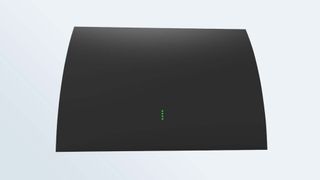Tom's Guide Verdict
A powered follow up to Mohu's previous, stylishly curved antenna, the Arc Pro is beautiful and good enough to pick up some tough-to-receive stations.
Pros
- +
Attractive styling
- +
Signal strength indicator
Cons
- -
Pricier than most
- -
Modest overall receptivity
Why you can trust Tom's Guide
Range: 60 Miles
Channels Received: 34
Amplified: Yes
1080p Reception: Yes
Cable Length: 10 Feet
Size: 8 x 11.5 x 2.25 inches
It's not always just about numbers. Sometimes it's about the quality of service–and style. And that's what some viewers should appreciate about the Mohu Arc Pro. The indoor amplified antenna didn't pull in many more stations than similarly priced powered antennas that we've tested lately (such as the Antop HD Smart Antenna SBS-301), but it did demonstrate some of the benefits of powered models by managing to receive some more popular broadcasts, which will endear it to most TV viewers. And it looks great. The Mohu Arc Pro model essentially replaces the Mohu Curve 50 (a long-time favorite of ours) which is being discontinued.
Mohu Arc Pro review: Design
As the name suggests, the Mohu Arc Pro sweeps back in a vertically oriented curve, perched solidly on a supplied plastic stand. It's similar in appearance to the earlier Mohu Curve, although our test model was jet black versus the previous model's alabaster finish. The Arc's overall footprint is similar (11.5 inches wide), as well, and the clip-on stand is slightly smaller (about 2 inches deep). All together, the Mohu Arc Pro measures 8 x 11.5 x 2.5 inches when assembled with the included stand.

While definitely attractive, the Mohu is not ideal for a wall or window placement. It's more comfortable sitting upright on a table top or entertainment system credenza. If you insist or have no alternative, there are two holes in the back of the antenna stand to hang it like a picture frame.The other major difference compared to Mohu's earlier, similarly shaped model is that this powered model has a set of 4 green LEDs on the face of the antenna that act as signal strength indicators. The more LEDs that light up, the stronger the signal.
Mohu Arc Pro review: Setup
Installing and positioning the antenna is simple enough. A connecting coaxial cable is permanently attached to the back of the antenna. It can either go straight from the Mohu Arc into the back of your TV or into a supplied amplifier, which then connects to a USB adapter for power and to the back of your set. The amplifier is tiny—no bigger than three sticks of gum stuck together—so it's easy to conceal without creating an eyesore.
To find the sweet reception spots, the LED signal indicators are helpful, but it's not a perfect solution. We found that one could situate the antenna in spots where the lights would flicker annoyingly. So you may have to move it a few times to find a position where the lights stay solid.
Mohu Arc Pro review: Performance
In our standard test location and using our test Samsung KS9000's TV tuner, the Mohu Arc Pro was able to get 2 of the 4 green signal indicator LEDs to light up. (In order to maintain a consistent comparison with other models we've tested, we did not reposition it.) An initial scan of over-the-air stations turned in 39 channels in total. However, as always, we viewed each channel to see how many were actually watchable, which ultimately revealed just 34 consistently viewable stations.

While it didn't receive an inordinate number of stations, the Mohu Arc Pro was able to tune in some stations that eluded other models. It pulled in the local CBS station at the bottom of the band, for example, as well as associated sub stations broadcasting Martha Stewart reruns. Better still for families, the Arc captured the PBS stations located in an adjacent state; very impressive indeed. Mainstream Spanish language stations from Telemundo, Umas, and Azteca came in clearly. There were also the usual retro TV channels like MeTV running ancient episodes of Matlock.
For comparison purposes, we also retested the now discontinued amplified Mohu Curve 50. It turned in a list of 39 stations in an initial scan, but when we auditioned all the channels, it turned out only 22 were watchable—far fewer than the Mohu Arc. Furthermore, several important stations were missing, including CBS, Fox, and the local PBS channels.

The Mohu Arc Pro also narrowly outperformed the Antop HD Smart Antenna SBS-301, another amplified indoor antenna rated for a larger 70-mile-radius range. Where the Antop pulled in 33 watchable stations, the Mohu Arc Pro offered 34 clear channels, despite having an ostensibly smaller 50-mile range.
Overall, we found the Mohu Arc Pro performed comparably to the Antop HD Smart Antenna SBS-301 amplified antenna, which was also able to capture stations like the local CBS affiliate and costs about the same as the Mohu Arc Pro. However, if you live in a densely populated metropolitan area with lots of local broadcasts, you may not need an amplified antenna. To see what's available in your area, you can check for local stations at AntennaWeb.org.
Mohu Arc Pro review: Verdict
We were generally happy with the Mohu Arc Pro's reception. It delivered more critical or mainstream stations than most of the models we've tested since the FCC began reassigning specific frequencies to stations. And if an antenna can be said to be attractive this table-standing model certainly is that.
Our only criticism of the Arc Pro is its price. While it is a worthy successor to the previous Mohu Curve 50 by offering better signal interference suppression, for example, there are many non-amplified models available for less than half the price of the Arc. And if you live in a densely populated metropolitan area with lots of stations, you may find a non-amplified model such as the Mohu Leaf Metro can do just as well for less than $20.
John R. Quain has been reviewing and testing video and audio equipment for more than 20 years. For Tom's Guide, he has reviewed televisions, HDTV antennas, electric bikes, electric cars, as well as other outdoor equipment. He is currently a contributor to The New York Times and the CBS News television program.


